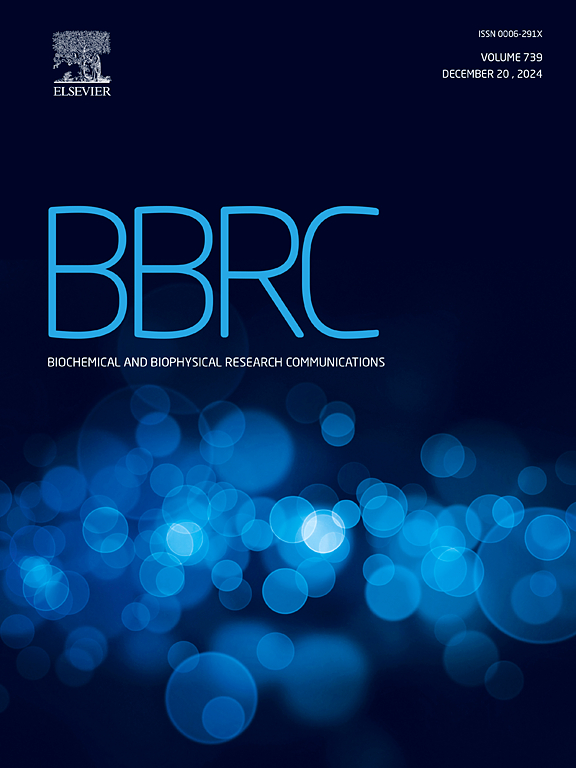缓激肽通过调节PI3K/AKT/mTOR信号通路,减弱niso4诱导的MIN6细胞自噬,保护小鼠胰岛功能。
IF 2.5
3区 生物学
Q3 BIOCHEMISTRY & MOLECULAR BIOLOGY
Biochemical and biophysical research communications
Pub Date : 2025-02-01
DOI:10.1016/j.bbrc.2024.151265
引用次数: 0
摘要
先前的研究表明,硫酸镍(NiSO4)增加了甲状腺细胞和组织的自噬。胰腺作为内分泌系统的重要器官,除了具有消化的外分泌功能外,还具有调节血糖的内分泌功能。然而,NiSO4是否增加胰腺自噬仍不清楚。缓激肽(BK)是缓激肽-激肽系统(KKS)的重要组成部分,具有减少自噬等多种生物学功能。本研究旨在探讨BK对niso4诱导的胰腺内分泌功能变化的影响。本研究结果表明,NiSO4在一定范围内提高小鼠空腹血糖(FBG),降低胰岛素水平。此外,NiSO4通过上调微管相关蛋白1轻链3-II (LC3II)和Beclin 1,下调p62,触发MIN6细胞的不完全自噬。机制上,NiSO4通过抑制PI3K/AKT/mTOR信号通路导致自噬异常激活。此外,在暴露于NiSO4的小鼠中,BK降低了FBG并增加了胰岛素分泌。光镜和透射电镜(TEM)分析显示,BK预处理能部分恢复MIN6细胞活力,减少自噬体的数量。在niso4诱导的MIN6细胞中,BK显著上调LC3II和Beclin1蛋白水平,下调p62蛋白水平。此外,BK增加磷酸化磷脂酰肌醇3-激酶(P-PI3K)、磷酸化蛋白激酶B (P-AKT)和哺乳动物雷帕霉素靶蛋白(mTOR)的水平。用HOE140 B2R抑制剂治疗后,BK的这些作用大部分被逆转。本研究结果表明,BK通过b2r介导的PI3K/AKT/mTOR信号通路的激活和自噬的抑制,改善了niso4诱导的胰腺β细胞功能障碍。本文章由计算机程序翻译,如有差异,请以英文原文为准。
Bradykinin attenuates NiSO4-induced autophagy in MIN6 cells and protects islet function in mice by regulating the PI3K/AKT/mTOR signaling pathway
Previous studies have shown that nickel sulfate (NiSO4) increases autophagy in thyroid cells and tissues. As an important organ of the endocrine system, the pancreas not only contributes to the exocrine function of digestion but also has the endocrine function of regulating blood sugar. However, it remains unknown whether NiSO4 increases pancreatic autophagy. Bradykinin (BK) is an important component of the kallikrein–kinin system (KKS) and has many biological functions, such as reducing autophagy. The purpose of the present study was to explore the effects of BK on NiSO4-induced changes in pancreatic endocrine function. The present results demonstrate that NiSO4 increases fasting blood glucose (FBG) within a certain range and decreases insulin levels in mice. Moreover, NiSO4 triggers incomplete autophagy in MIN6 cells by upregulating microtubule-associated protein 1 light chain 3-II (LC3II) and Beclin 1 but downregulating p62. Mechanistically, NiSO4 leads to abnormal activation of autophagy by inhibiting the PI3K/AKT/mTOR signaling pathway. Moreover, BK decreases FBG and increases insulin secretion in mice exposed to NiSO4. Light microscopy and transmission electron microscopy (TEM) analyses revealed that BK pretreatment partially restores MIN6 cell viability and decreases the number of autophagic bodies. BK significantly upregulates the protein levels of LC3II and Beclin1 but downregulates p62 in NiSO4-induced MIN6 cells. In addition, BK increases the levels of phosphorylated phosphatidylinositol 3-kinase (P-PI3K), phosphorylated protein kinase B (P-AKT) and mammalian target of rapamycin (mTOR). Most of these effects of BK are reversed by treatment with the HOE140 B2R inhibitor. The present results suggested that BK ameliorates NiSO4-induced pancreatic β-cell dysfunction through B2R-mediated activation of the PI3K/AKT/mTOR signaling pathway and inhibition of autophagy.
求助全文
通过发布文献求助,成功后即可免费获取论文全文。
去求助
来源期刊
CiteScore
6.10
自引率
0.00%
发文量
1400
审稿时长
14 days
期刊介绍:
Biochemical and Biophysical Research Communications is the premier international journal devoted to the very rapid dissemination of timely and significant experimental results in diverse fields of biological research. The development of the "Breakthroughs and Views" section brings the minireview format to the journal, and issues often contain collections of special interest manuscripts. BBRC is published weekly (52 issues/year).Research Areas now include: Biochemistry; biophysics; cell biology; developmental biology; immunology
; molecular biology; neurobiology; plant biology and proteomics

 求助内容:
求助内容: 应助结果提醒方式:
应助结果提醒方式:


